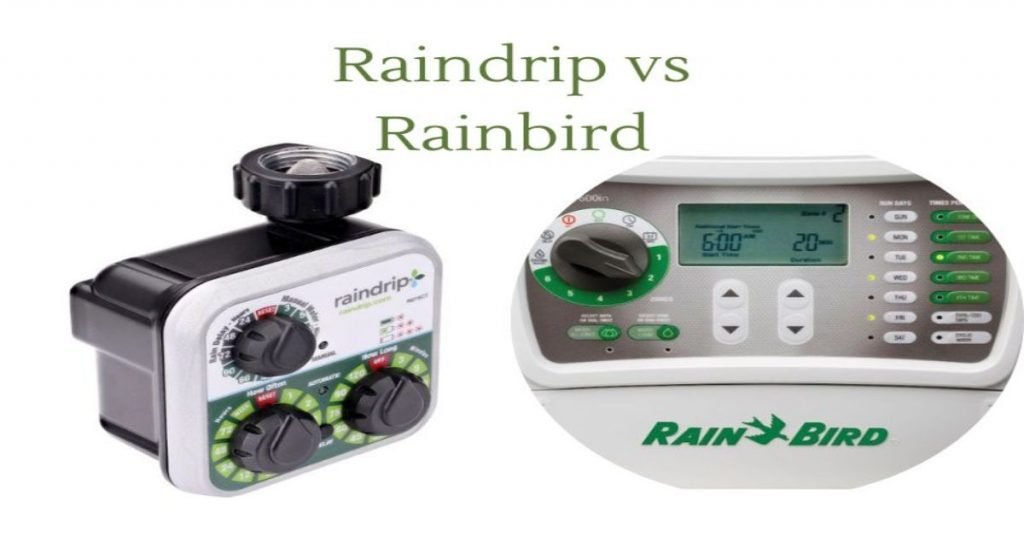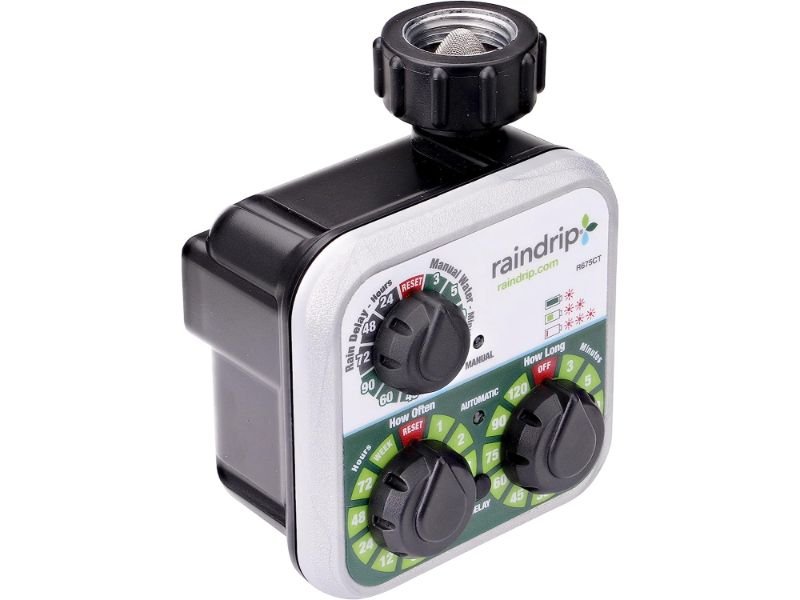Raindrip and Rainbird are both well-known brands in the field of irrigation systems and have long been trusted by gardeners for years. Nonetheless, it can be challenging to determine which one is the best fit for your gardening needs. In this special segment, we’ll delve into a detailed comparison between Raindrip vs Rainbird to find whether these watering systems are worth every penny. Let’s get started!

Table of Contents
Raindrip and Rainbird: The Key Different
Both Raindrip and Rainbird are known as plant enthusiasts’ best friends in terms of minimizing water waste and promoting efficient water usage. While they share a common goal, one notable difference between Raindrip and Rainbird makes them distinguishable.
Raindrip, as the name indicates, specializes in micro-irrigation or drip irrigation systems. It provides a drip irrigation kit that delivers water directly to the plant’s roots. Raindrip systems generally consist of small tubes or hoses with emitter tubing that releases water slowly and directly onto the soil. Raindrip features automatic watering kits with a timer that is suitable for flower beds, shrubs, ground cover areas, vegetable gardens, containers, and hanging baskets.

On the other hand, Rainbird not only covers limited-space gardening areas like containers, but it also offers a wider range of irrigation systems, including drip systems, traditional sprinklers, and micro-sprinkler systems. While Raindrip’s automatic watering kits are not recommended for lawn use, Rainbird provides an automatic sprinkler system kit that can be easily installed into the ground that can cover larger areas with extensive plantings.

Small Scale Gardens vs Larger Garden Areas
As implicitly mentioned in the previous section, it’s clear that plant enthusiasts with broader gardening areas should opt for Rainbird. The comprehensive size of sprinkler systems offered by Rainbird provides widespread coverage of expansive lawns and landscape beds–and it can cover areas approximately as far as 40 feet (12 meters).
But in the combat between Raindrip vs Rainbird, it doesn’t mean that Raindrip is completely defeated. This water-efficient irrigation system still excels in smaller-scale gardens, thus targeting precise watering for individual plants. Luckily for gardeners, the ease of maintenance between Raindrip vs Rainbird is not solely determined by the different gardening areas they cover. But mainly, Raindrip systems are considered easier to install compared to its competitor.
Also Read:
- Gardening Books: Essential Reads for Green Thumbs
- DIY Garden Projects: Creative Planting Ideas
- The Ultimate Guide to Organic Fertilizers for Healthy Plant Growth
- Must-Have Garden Insecticide for Pest Control Solutions
- Top 10 Essential Gardening Tools Every Plant Lover Should Have
The Cost Effectivity in the Long Run: Few Aspects to Note
Determining which between Raindrip vs Rainbird is more cost-effective requires gardeners to consider a few factors. The first thing that plant lovers need to do is to evaluate the upfront costs. Rainbird, because this irrigation system covers larger gardening areas, often incorporates features such as weather sensors, smart controllers, adjustable nozzles, and adjustment tools–which contribute to its higher price range.
For instance, the WiFi controllers provided by Rainbird to help gardeners control their irrigation system can cost anywhere from $99 to $200. Materials such as sprinklers or sprayers, rotors, nozzles, and emitters are not included. On the contrary, the simplicity and ease of installation of Raindrip typically require fewer components and materials, resulting in lower costs. The price range of Raindrip materials goes anywhere between as little as $5 to as high as $300.
Next, gardeners need to examine the costs of energy. Although both Rainbird and Raindrip generally require little to no electricity, some optional add-ons and accessories require power for operation–especially those involving sprinkler heads and controllers. Inspecting the warranty by each manufacturer also offers added value by covering replacement for parts and repairs, reducing the long-term costs in general.
Rainbird vs Raindrip Battle: Which is the Best Irrigation System for Flower Beds?
Fortunately, in the war of Rainbird vs Raindrip, both irrigation systems can be the perfect options for delicate and vibrant flowering plants. The choice between Raindrip and Rainbird ultimately depends on factors such as the size of the flower beds, the specific watering needs of the flowering plants, and your budget.
Are There Other Alternatives for the Outdoor Garden Irrigation System?
Aside from the debate between Raindrip vs Rainbird, there are several alternative methods plant enthusiasts can try to provide water without relying on an irrigation system. The first and classic way, which you can name it, is by manual hand watering. Gardeners can use a watering can or hose to manually water the plants, which also allows gardeners to have direct control over the amount of water used.
If you want to go by a more natural approach, applying a layer of mulch around plants also helps retain moisture in the soil and reduce evaporation. Mulch acts as a protective barrier, preventing water loss, and thus, reduces the frequency of watering needs. Another alternative to try is a soaker hose. A soaker hose is a porous hose that releases water slowly and evenly along its entire length and can be placed at the base of plants or buried slightly below the soil. Unlike manual hand watering, the disadvantage of soaker hoses is that the release of water can’t be controlled.
DripWorks and DIG: Substitutes for Raindrip and Rain Bird?
Raindrip and Rainbird are not the only players in the game. DripWorks and DIG Corporation are other reputable brands that offer irrigation solutions as worthy alternatives. DripWorks offers products such as tubing, emitters, filters, valves, and timers, allowing for precise and efficient watering. The price ranges from $10 to $600. They’re mainly offering kits and components that are needed for the irrigation system setup.
Meanwhile, DIG Corporation is known for its drip irrigation systems and accessories, including vinyl micro-tubing, soaker tape, Bluetooth hose, and batteries for irrigation controllers. Gardeners can expect the price to be in the $5 to $250 range. So if you are not sure whether to choose between Raindrip vs Rainbird, both DripWorks and DIG irrigation systems can be the perfect replacement or be used together with either Raindrip or Rainbird products.
Closing Remarks
As a finishing line to which between Raindrip and Rainbird is worth investing in, it’s also crucial to carefully consider the specific gardening needs, the gardening size, as well as a personal budget. Both Raindrip and Rainbird offer the best and most reliable irrigation systems with their features. While Raindrip is more suitable for micro-irrigation systems, Rainbird offers a wide range of irrigation solutions that is flawless for larger gardening areas.

New author in the hood. Loves gardening and flowers are my spirit animals (yes I know they are not animals but I insist). I will be covering most of the flowers’ topics here and occasionally random though as well.






